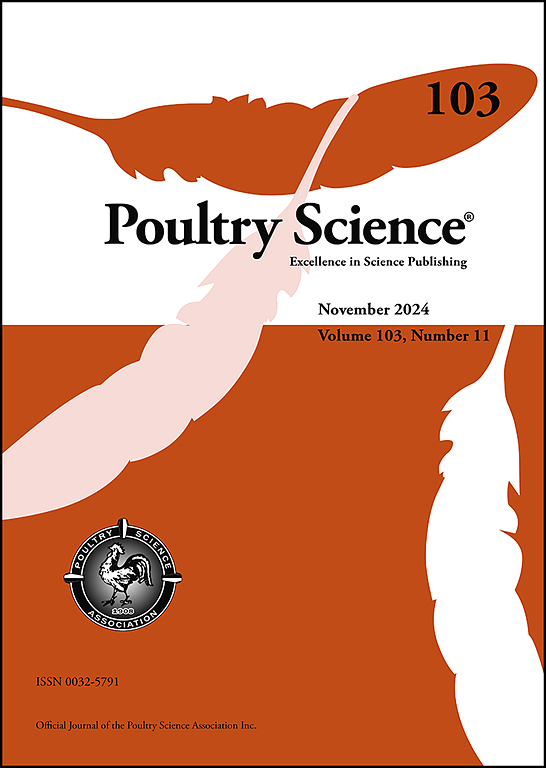From gut microbiota to host genes: A dual-regulatory pathway driving body weight variation in dagu chicken (Gallus gallus domesticus)
IF 3.8
1区 农林科学
Q1 AGRICULTURE, DAIRY & ANIMAL SCIENCE
引用次数: 0
Abstract
During the growth and development of animals, there is an interaction between the gut microbiota and the host genotype. The host genotype can regulate the microbiota, and in turn, the microbiota can influence host gene expression, thereby affecting the animal's production performance. This study explored the dynamic interplay between the gut microbiota and host gene expression in body weight variation in Dagu chicken, an indigenous poultry genetic resource in China. We characterized mucosa-associated microbiota across four gastrointestinal segments (duodenum, jejunum, ileum, cecum) and ileocecal chyme microbiota in 12-week-old Dagu chickens stratified by divergent body weight phenotypes, while simultaneously quantifying region-specific intestinal epithelial transcriptional regulation. 16S rDNA sequencing was employed to identify Firmicutes as the predominant bacterial phylum, with notable differences in the abundance of specific genera (e.g., Ligilactobacillus and Lactobacillus) being observed between the high- or low-body-weight groups. Enhanced biosynthesis pathways were functionally predicted in heavier roosters, whereas reduced nutrient metabolism pathways were contrasted. A conserved functional concordance was observed between regionally predominant differential microbiota and the physiological specialization of corresponding intestinal niches. Functional analysis revealed that the high-body-weight group demonstrated superior capabilities in microbial biosynthesis, whereas the low-body-weight group exhibited enhanced microbial metabolic activity. NAA80 was identified as the common differentially expressed gene across all intestinal epithelial tissues. The Gene Ontology and KEGG pathway analyses revealed elevated nutrient absorption efficiency in the high-body-weight group, while the low-body-weight group demonstrated accelerated cellular renewal rates and shorter cycles. Correlation analysis identified significant associations between gut microbiota and host genes expression profiles, with the majority of correlations being positive. These results suggest a coordinated interaction between microbial communities and host genetic regulation, potentially driving phenotypic differences in body weight performance.
从肠道菌群到宿主基因:大沽鸡体重变化的双调控途径
在动物生长发育过程中,肠道菌群与宿主基因型之间存在相互作用。宿主基因型可以调节微生物群,反过来,微生物群又可以影响宿主基因的表达,从而影响动物的生产性能。本研究探讨了大沽鸡肠道菌群与宿主基因表达在体重变化中的动态相互作用。大沽鸡是中国本土家禽遗传资源。我们对12周龄大沽鸡四个胃肠道段(十二指肠、空肠、回肠、盲肠)的粘膜相关微生物群和回盲食糜微生物群进行了表征,并对区域特异性肠上皮转录调控进行了量化。采用16S rDNA测序确定厚壁菌门为优势菌门,在高体重组和低体重组之间观察到特定属(如liilactobacillus和Lactobacillus)的丰度存在显着差异。从功能上预测,较重的公鸡的生物合成途径增强,而营养代谢途径则减少。在区域优势的差异微生物群和相应肠道生态位的生理特化之间观察到保守的功能一致性。功能分析显示,高体重组表现出更强的微生物合成能力,而低体重组表现出更强的微生物代谢活性。NAA80是所有肠上皮组织中共同的差异表达基因。Gene Ontology和KEGG通路分析显示,高体重组的营养吸收效率提高,而低体重组的细胞更新速度加快,周期更短。相关分析发现,肠道菌群与宿主基因表达谱之间存在显著相关性,且大多数相关性为正相关。这些结果表明,微生物群落和宿主遗传调控之间存在协调的相互作用,可能导致体重表现的表型差异。
本文章由计算机程序翻译,如有差异,请以英文原文为准。
求助全文
约1分钟内获得全文
求助全文
来源期刊

Poultry Science
农林科学-奶制品与动物科学
CiteScore
7.60
自引率
15.90%
发文量
0
审稿时长
94 days
期刊介绍:
First self-published in 1921, Poultry Science is an internationally renowned monthly journal, known as the authoritative source for a broad range of poultry information and high-caliber research. The journal plays a pivotal role in the dissemination of preeminent poultry-related knowledge across all disciplines. As of January 2020, Poultry Science will become an Open Access journal with no subscription charges, meaning authors who publish here can make their research immediately, permanently, and freely accessible worldwide while retaining copyright to their work. Papers submitted for publication after October 1, 2019 will be published as Open Access papers.
An international journal, Poultry Science publishes original papers, research notes, symposium papers, and reviews of basic science as applied to poultry. This authoritative source of poultry information is consistently ranked by ISI Impact Factor as one of the top 10 agriculture, dairy and animal science journals to deliver high-caliber research. Currently it is the highest-ranked (by Impact Factor and Eigenfactor) journal dedicated to publishing poultry research. Subject areas include breeding, genetics, education, production, management, environment, health, behavior, welfare, immunology, molecular biology, metabolism, nutrition, physiology, reproduction, processing, and products.
 求助内容:
求助内容: 应助结果提醒方式:
应助结果提醒方式:


